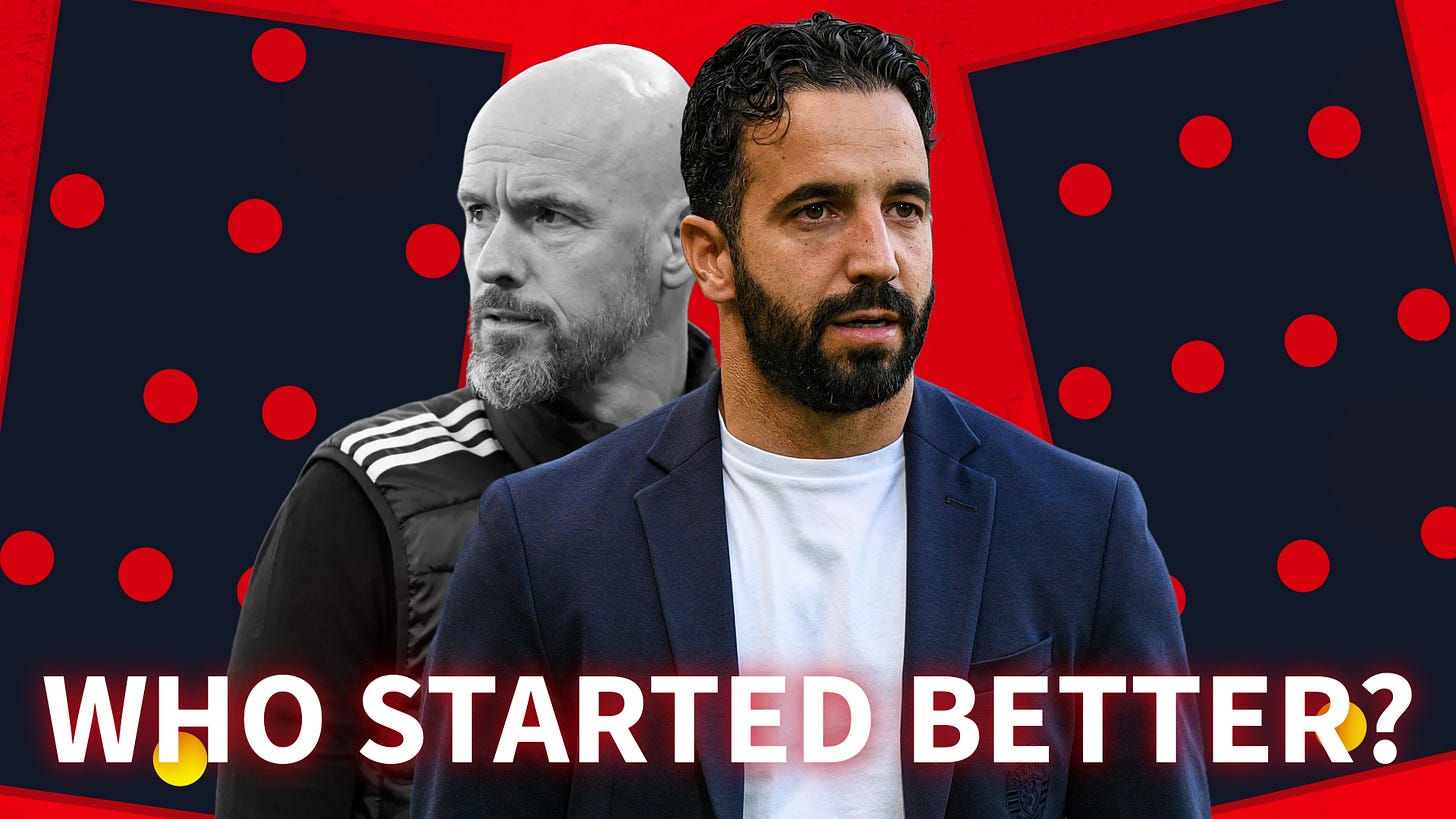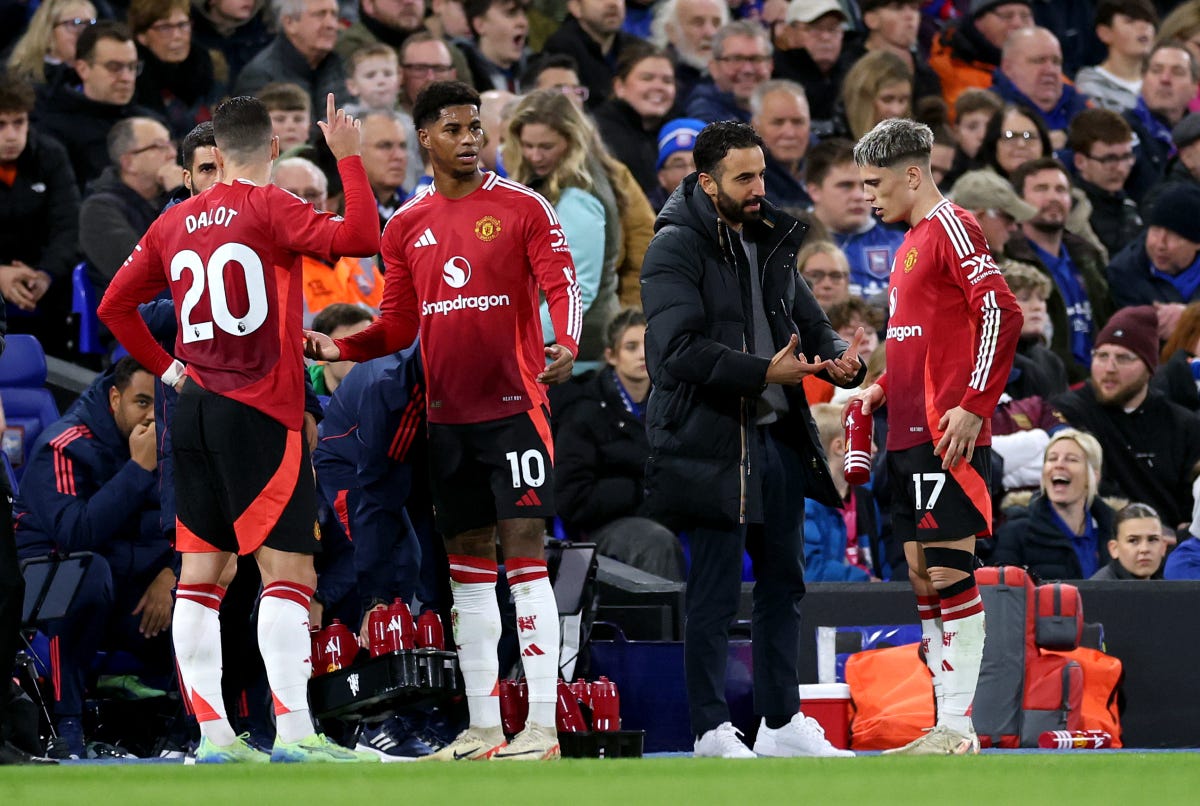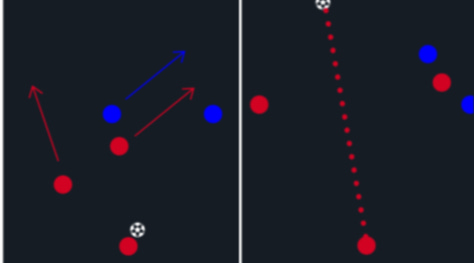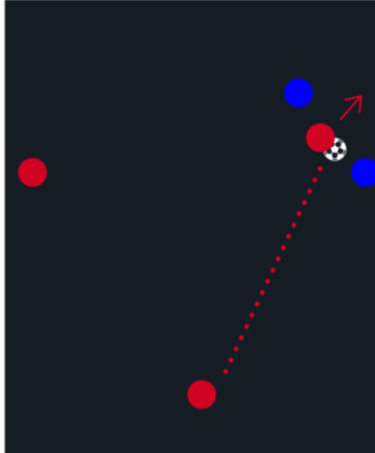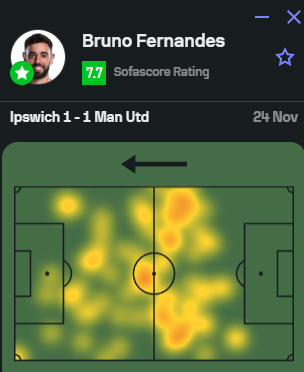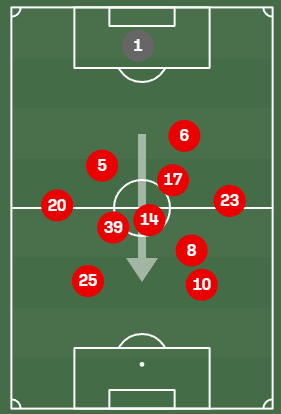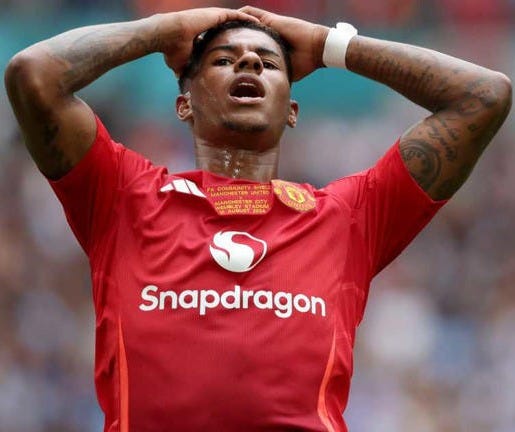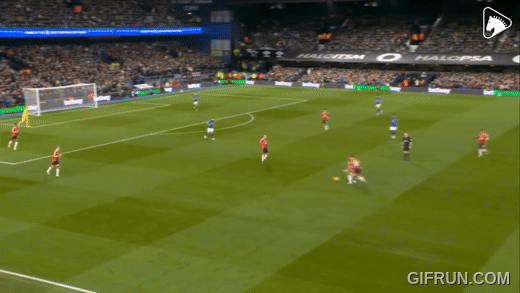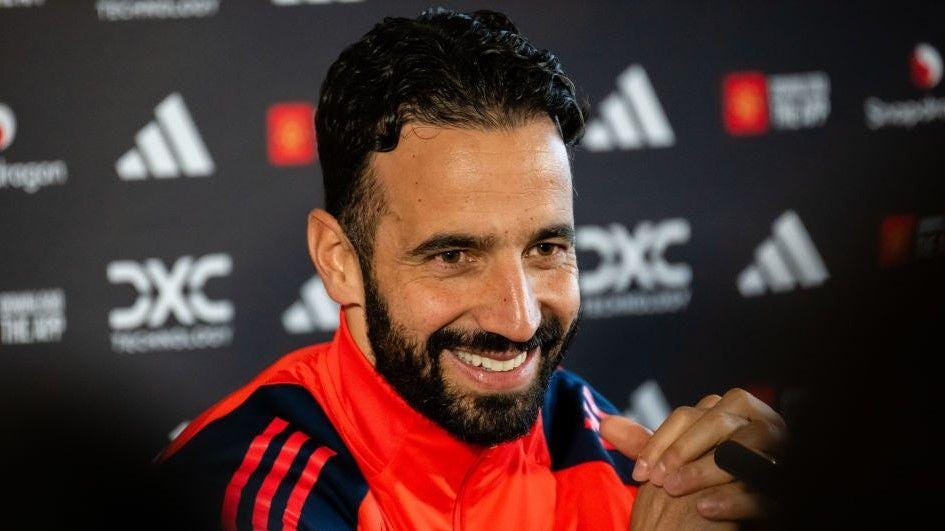Ten Hag or Amorim: Whose First League Showing Was Better?
Ruben Amorim is the latest in an ever-lengthening line of managers tasked with bringing the Red Devil's back to glory. Now that he has finally managed his first game, let's compare it with Ten Hag's.
Outside Factors
Before beginning, let’s get the almost contractual contextual information out of the way. There are some clear differences in the situations surrounding both of these managers first games in charge. Erik Ten Hag had a 108 day period (between April 21st and August 7th) in which his coaching style and structure could be learned and adopted by the incumbents at the club in time for their first game; a stark contrast to the 2 days that Amorim has claimed to have had at Manchester prior to the Ipswich fixture. Additionally, Ten Hag was given over 230 million euros to spend on new players in his first summer at the club, compared to Amorim who will have to work with what he’s got given that the transfer window has already shut. These facts at the very least are worth mentioning when considering the titular question, and some leniency may be fairly given to Amorim and his team with them in mind.
One other key consideration is the opponent. Football is not a one team sport and its only fair to grade the performance of one team whilst considering the ability of the other. In this area, Amorim arguably had an easier job than Ten Hag. Amorim’s first opponent Ipswich, whilst maybe underrated by the average fan, probably do deserve to be where they are at the foot end of the league. They possess some quality individual talent such as Omari Hutchinson and Leif Davis, but the spine of the team seemed to reach its peak at a top Championship level.
Ten Hag’s first game on the other hand was against Graham Potter’s Brighton back in 2022, a side which gained a reputation for punching above its weight. Potter’s Brighton could boast impressive numbers against even the best teams in the Premier League and would go into matches against the big six sides with a sense that a result was possible. They weren’t special however, 2022 Brighton could often be caught playing a very non-progressive ‘piggy in the middle’ style of football where their high statistical output would not be properly converted on.
The merits and criticisms of both Brighton and Ipswich could be studied in detail, and you can make a fair argument that Ten Hag had the harder fixture, but when considering the reputation, the player quality and the history of Manchester United, it does not seem unfair to say that they should be able to win against both.
Now that we’ve looked at the outside factors, lets take a look at the performance of Manchester United in these two games:
Shapes
One area where Ten Hag’s men were clearly better than Amorim’s is the understanding of the shape of the formation, specifically when in possession and creating passing squares and triangles. This is mainly owing to Ten Hag having more time with his side and the 4-3-3 he deployed being a more conventional shape both for Manchester United and just football generally. Amorim’s side on the other hand certainly felt like they’d only been playing his new 3-4-2-1 shape for two days; especially in the wider areas. Two key issues that came up were a misunderstanding of who should be where when creating attacking triangles (specifically on the left but also on the right) and Bruno Fernandes straying too far from his position.
The triangle on the left flank (Eriksen, Dalot, Garnacho) seemed to have serious coordination issues with the ball. Garnacho was very successful at making incisive inverted runs, though through a mixture of them being rather one note and the midfield rarely being able to find him in the channels they would often have little impact. In a vacuum inverted attacking runs can be extremely effective even if the midfield doesn’t pick them out because they can drive the defensive line into a narrower formation allowing for another player to attack down the wings. If United intend to develop attacks in this manner, they will need to drill it much better. It was too common in the match that Eriksen could either not make the forward diagonal pass because Dalot had not made a run, or he would make the pass and there would be nobody there to receive it.
Amorim’s structure tends to have a certain rigidity to its back 3 and wing backs, making a sort of bowl formation. In the long term it seems more likely that he will want his midfielders to play a pass into the inverting player rather than the wing-back as it provides more progressive and dynamic opportunities for the rest of the team to make their own movements. It also more effectively brings the striker into the game.
The second issue regarding shape that Ruben Amorim’s team had was that Bruno Fernandes does not seem at all suited to the position that he was in. Fernandes is simply not the style of player that belongs in that inside forward role, and his heatmap shows that he is unable to get into the required positions for him to be able to link to the striker or have a go himself.
zero entries into the right half of the box is frankly putrid when that is the primary job of your position. Fernandes did not have a bad game however, he played many important passes and managed to control the deeper parts of the midfield well. It just seems that he needs to play in the central midfield, allowing for someone more suited to running at the defence and challenging the box to play further up. Amorim’s Sporting CP used Francisco Trincao in the position that Bruno Fernandes was put in, if you compare the profile of the two players, its pretty clear the tricky dynamism that made Trincao so successful in this system is something Fernandes simply does not possess.
Possession
conventionality of ideas is a massive boon when a new manager is trying to imprint their footballing philosophy on a club, not only does it ensure that players will have an easier time understanding what the new manager is bringing to the table, but also increases the likelihood that they’ve already played under a similar system before. In this way Erik Ten Hag came in with a massive leg up over Ruben Amorim as the Dutch brand of wing focused play that he specialised in is a very popular idea in modern football and aligns quite nicely with the classic Manchester United Brand. When in possession, Ten Hag’s men had a good idea about who would be open to passes and when, as well as where on the pitch the opponent would trigger press them and force them to cycle play. Re-watching Ten Hag’s Manchester United against Potter’s Brighton, it felt that they created enough chances with their build up play but they lacked the final pass or the quality to finish. They managed to dominate possession against a Brighton team that was obsessed by it, outshoot them and create the same amount of big chances yet only managed to score via an Alexis Mac Allister own goal.
The average position map against Brighton tells a story on its own. The wing-backs were up high to develop play, and Bruno Fernandes(8) was sitting off the side of the Fred(17)/McTominay(39) pivot playing in the half spaces in a very similar fashion to James Maddison this season under Ange Postecoglou. The issue was that there was absolutely nobody upfront, Eriksen(14) is supposed to be the striker in this formation and yet he is sat deeper than defensive midfielder McTominay. It was not as if the wingers were cutting in to play off of a false nine, the space was just empty. Not knowing who to consistently put at the tip of the spear was a problem that typified the entire Ten Hag era; in spite of their chance creation they were too wasteful with the final ball or the shot, and they would never look impressive because of it.
Ten Hag’s United have often been criticised for not having a clear style of play there is definitely an argument that the reason so much chopping and changing was necessary was the lack of consistency upfront. There was that impressive Rashford purple patch and every few games it would all seem to click for the forwards but the Red Devils’ attack could never quite get fully operational. All resulting in Ten Hag having to make changes to make it work. When looked back at now, Ten Hag’s first match feels like a warning about the persistent issues to come, playing generally good football but with no end product.
By contrast, Ruben Amorim’s first Manchester United side clearly lacked understanding about what to do with possession in ‘Amorim-ball’. In some instances the reds were too indirect in possession whilst in others they were far too aggressive. At times the likes of Diallo and Fernandes were recycling obvious attacking opportunities all the way back to the defence; even Amorim was visibly unimpressed when they did that. This issue might have been accentuated on the right flank where Fernandes had been dropping too deep to effectively drive at the defence from the wing, but even the defence themselves would at times be too slow at moving the ball up to the next line. There was too many inefficient passes that would not progress the ball and in a couple of situations they flat out passed the ball too slowly. In other situations the team would be far too direct, making overly ambitious passes which at best would result in one attacker running against multiple defenders. Even the goal that United scored was a failure - though an effective one - to properly play the system that they’d set out for; being a more Fergie-esque sprint down the wing than a quickly worked Amorimian move. Really the beautiful run that Diallo made to set up Rashford should be something that the player playing in Fernandes’ position should be doing. Amorim’s United need to better understand what areas they should be looking to start attacks from, and when to recycle when not in those areas. That will most likely come eventually, a certain amount of leniency is warranted given that they’ve had very little time to adopt such a non-conventional structure.
Defensive Duties
Unsurprisingly, the defensive structure of Amorim’s back 5 was more solid than Ten Hag’s 4. Neither were particularly impressive, Ten Hag’s men lost Pascal Gross basically any time Brighton had the ball whilst Amorim’s team conceded a sloppy (though well struck) goal against Ipswich Town who have a -10 goal difference as of the match against United. Amorim’s united could occasionally be caught on the break in the wider areas, such as when Hutchinson performed an unbelievable off-balance turn on Johnny Evans and passed it down the right to Wes Burns. Realistically this is just a product of the system Amorim wants to play, his back 5 will always have a transitional gap on the wings because his wing-backs have to attack and defend. Its a weakness that can only be minimized by dominating the ball and effectively pressing from the front.
Player Quality
The discussion of player quality of each team is an important but honestly rather simple one. Amorim’s side is better than Ten Hag’s was. This is because it is the same side, except the defence has been upgraded, the goalkeeper better suits possession football, and the midfield has become stacked with some of the best talent in the league. The cavernous gap in ability between the Fred/McTominay pivot with Donny van de Beek as a backup and the group of Mainoo, Ugarte, Fernandes, Eriksen and Casemiro is frankly not ignorable. Assuming Amorim drops Fernandes deeper in the future and pairs him with the likes of Mainoo or Ugarte Manchester United are certain to have a world class midfield within the next couple of years.
An interesting similarity between both Amorim’s first side and Ten Hag’s is that neither of them appeared to have a natural striker that they can play upfront. Ten Hag played Eriksen up top in his first showing which as explained above was clearly not a position he was suited to. Amorim on the other hand placed Rashford upfront who up to this point in his career has never looked anywhere near as good as a 10 as he does when playing wider. Its not impossible that Amorim turns him into a top class striker, but as things stand there’s no evidence that he suits that role.
Both Manager’s arguably did not put their best side out, Ten Hag left Cristiano Ronaldo on the bench for example whilst Amorim should be looking to the likes of Ugarte and Mount in the future to fill the roles that his first eleven were not sufficient in. This article only accounts for the players that did play, but even if you we’re to include the possible future tweaks and player changes Amorim’s side is still quite clearly better. Ten Hag’s side severely lacked first team quality depth on the bench whilst you could make an argument that five or six of Amorim’s first starting eleven aren’t even the best in their position at the club.
So… Whose First League Showing Was Better?
In spite of the odds stacked against Amorim with how little time he had, It feels like he did actually outperform Ten Hag who had multiple months. To state the obvious one point is better than none, but excluding the result Ruben Amorim’s first 90 provided a more hopeful outlook on the future than Ten Hag’s match against Brighton. Perhaps the bias of retrospectively knowing that Ten Hag’s team would fail plays a part in this feeling, at the end of the day its easier to say why something failed in the past than why something will do in the future. But Ten Hag’s first match against The Seagulls did not feel like much of a marked improvement from 2021/2022 Ralph Ragnick side that came before it.
Amorim’s team by comparison feels very developmental and may not click for a while yet. He probably got less out of the game than van Nistelrooy would have by building on Ten Hag’s structure, but Sporting CP have proved that Amorim’s ideas have merit and the Ipswich game displayed progress toward adopting them. Garnacho and Diallo were two players who look to have already picked up the system, at least more so than the others. If that can spread to the rest of the squad Amorim’s Manchester United project could be greatly successful. Ultimately that was not a statement you could have made after Ten Hag’s first outing and that is the simple difference between the two.
Only time will tell if things will work out for Amorim at Manchester United, but the tale of the last decade is not kind to his prospects.




